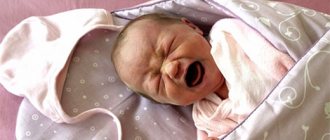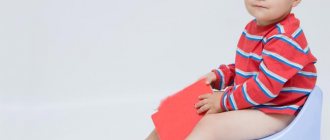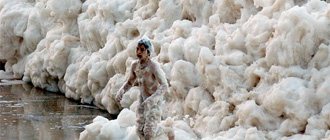The reasons for the appearance of loose stools during artificial feeding and which mixture will eliminate the problem
In a child under 6 months, if he is exclusively breastfed, the stool will be liquid, the frequency of urges can increase up to 10 times a day, depending on the age of the baby.
If the number of bowel movements exceeds the specified amount, then we are talking about diarrhea. When the baby begins to eat not only liquid food, then his feces become already formed, in this case it is easier to determine whether the baby has digestive problems or not.
The following bowel movements are normal:
- In the first month of life, a child can defecate up to 10 times. The consistency is liquid. The act of defecation mainly occurs at the end of feeding.
- In the second month of life, the number of bowel movements is reduced from once every 2-3 days to 4 times a day. Depends on what type of feeding the child has.
- After 6 months, the feces become thicker, the number of bowel movements is reduced to twice a day.
- As the baby approaches one year of age, he defecates once a day or less.
Children under one year of age who are breastfed are less likely to suffer from diarrhea than formula-fed children.
What does diarrhea look like in infants and older children? Diarrhea is frequent, loose, even watery (sometimes foamy) stool. The stool may contain mucus.
You can tell if your child has diarrhea by the following signs:
- unpleasant odor;
- abundance of feces;
- the appearance of flakes or pieces of undigested food.
The consistency of stool largely depends on the cause of diarrhea.
Parents always pay special attention to what their baby’s stool looks like. And then, when intestinal dysfunction such as diarrhea develops in a child under one year old, young mothers develop severe anxiety. And it doesn’t matter how old the baby is - 2 weeks or 11 months. But in each specific case, the appearance of frequent or rare loose stools in young children is provoked by its own reasons, and often it is natural and does not pose any danger. Therefore, before you begin to help the baby, you should understand the etiology of this case of diarrhea from the accompanying symptoms.
It is not uncommon for parents to ask the question of which stool in a baby is not pathological diarrhea, because it is quite difficult to determine this on your own, since due to the babies’ digestive system not being fully formed, their bowel movements always have a liquid or mushy consistency with the smell of sour milk.
In order to promptly identify such diarrhea in an infant, which appeared as a result of any disease, you should first of all pay attention to the consistency of the stool and promptly find out why foreign inclusions and a pungent odor appeared in them. Normal feces are yellowish in color and look like very runny curds with a pleasant sour milky smell. Pathological diarrhea in a child up to one year old has the following symptoms:
- The presence of bloody streaks or mucus in the baby’s watery stool;
- Feces associated with childhood diarrhea are often green in color and have a strong aroma;
- Indigestion in an infant caused by pathogenic microorganisms can be identified by frequent and uncontrollable watery bowel movements;
- If a baby has diarrhea, abdominal pain, vomiting or high fever should also alert parents.
The above indicates a dangerous nature of the diarrhea that appears in the baby and requires immediate contact with a specialist. The main factor that a baby develops pathological intestinal dysfunction is not the number of bowel movements per day, nor the color or consistency of stool, since children under one year old can have bowel movements either rarely, 1-2 bowel movements per day, or excessively often, up to 20 times.
Their stool is usually very loose. Parents have repeatedly asked the question, what is the most alarming sign in children in this situation and why? Experts note that the most worrying thing is the baby’s loss of activity and appetite, as well as the presence of blood in the stool.
Parents are often interested in what diarrhea looks like in a baby on artificial nutrition, or in a child with regular breastfeeding, and why they may differ? First, you should find out the common cause that can cause loose stools in children under one year of age. It is pathogenic microorganisms that have entered the gastrointestinal tract, causing infections of various etiologies, accompanied by diarrhea.
- Diarrhea during breastfeeding in a child occurs mainly due to the mother’s consumption of inappropriate foods. In order to rid the baby of this pathology, it is enough for a woman to reconsider her diet when breastfeeding, to determine what causes the baby to loose bowel movements;
- You can often hear the question of why does a baby develop diarrhea during artificial feeding? Here, the main cause of indigestion is the difficulty of the child’s digestive organs in digesting the fats contained in the mixtures;
- Problems with watery stools also appear in babies who are mixed-fed. They also arise due to the appearance of inappropriate foods in the mother’s diet, or the use of an inappropriate mixture.
With mixed and artificial feeding, rotting processes predominate in the intestines, therefore, in the feces of infants, which comes out in the form of diarrhea, fermentative flora and E. coli predominate over lactic acid ones. Also, the mixed type of nutrition of the baby involves the presence of a small amount of mucus in the stool, which should not be taken into account, since this is not a pathology.
In all cases when diarrhea in an infant does not appear due to pathological diseases, the solution to the problem lies in correcting the diet. This can be achieved very simply; all a mother using breastfeeding needs to do is eliminate foods that can cause loose stools, or replace the formula that causes diarrhea with a more suitable one, which will allow children under one year of age to stop suffering from negative manifestations.
Deviations in stool consistency indicate changes in the baby’s healthy condition. Both parents should be able to distinguish normal stool from diarrhea in order to provide timely medical attention. You need to choose a special mixture for diarrhea in an infant, which will help safely eliminate the problem.
At the time of artificial feeding, somewhat different digestive processes occur in the baby’s body than in infants fed on mother’s breast milk. Diarrhea in a bottle-fed baby can occur for the same reasons as when breastfeeding. But there is a group of factors associated with mixtures.
Loose stools often occur due to dysbiosis, intestinal infections and as a result of changing the formula. An interesting fact about loose stools is the period of teething. Additional causes of diarrhea include:
- poisoning;
- mixing mixtures;
- premature introduction of complementary foods;
- intolerance to lactose/gluten components;
- inflammation of the appendix;
- intestinal obstruction;
- rotavirus infection;
- reaction to medications (usually antibiotics);
- a group of diseases associated with the penetration of parasitic worms into the human body;
- pancreatitis;
- state of stress.
Additionally, a cold or otitis media can cause diarrhea in children. There are many reasons for diarrhea formation. When the baby is weakened, looks lethargic and other suspicious signs are observed, call a doctor.
Before determining methods of treating diarrhea, you need to know the natural state of the stool of a formula-fed baby. The color of the stool should be brown, and the density of bowel movements should be slightly higher than that of an infant.
There are a wide range of treatments for diarrhea in infants. Before self-medicating, focus on the general condition of the child, and if necessary, seek the help of a specialist. It is important to begin the process of treating loose stools in the first hours of unpleasant symptoms. Observed diarrhea in a bottle-fed infant can be easily treated with medications, rehydration preparations (re-saturation of a previously dehydrated substance with water), antibacterial therapy, sorbents, biological products, and enzyme preparations.
| Drug treatment |
|
| Rehydration preparations |
|
| Antibacterial therapy |
| The need to use an antibiotic for diarrhea in a baby occurs only in twenty percent of cases. The indication for the use of the drug is the formation of a bacterial intestinal infection. Not all antibiotics are indicated for a small child. Doctors often opt for semi-synthetic penicillins, macrolides and cephalosporins. Most popular:
|
| Sorbents for diarrhea |
|
| Biological products |
|
| Enzyme preparations |
Symptoms of diarrhea depending on the cause
Frequent loose stools in a formula-fed newborn can have several different causes. Among them:
- incorrectly selected formula for feeding;
- rotavirus infection;
- staphylococcus;
- dysbacteriosis;
- intestinal infection;
- lactose intolerance;
- untimely introduction of complementary foods;
- teething;
- change of mixture;
- medicines;
- food poisoning;
- helminths;
- celiac disease;
- problems with the development of internal organs.
In a newborn, the digestive system is not fully formed, continues to form, and functions poorly. Therefore, it is so important to monitor the appearance of his stool from the first days, so as not to miss the onset of the disease or to adjust his diet in time. Diarrhea in a newborn with artificial feeding must be distinguished from normal feces. The feces of such children are thicker than those of those who drink mother's milk, it is homogeneous, and may contain underdigested white lumps of the mixture.
Diarrhea has a thinner consistency than normal stool, often yellow, sometimes green, with an unpleasant, sour odor. The frequency of stool increases. Feces may be streaked with blood, mucus, foam, or darker specks. All these signs are a reason to immediately contact your pediatrician.
Those immunomodulators and invaluable components of mother's milk that a breastfed newborn receives are absent in adapted formulas. Therefore, the immunity of a bottle-fed baby is much weaker. In this regard, there is a greater likelihood of infectious diarrhea caused by bacteria.
Another feeding mistake that can cause diarrhea in a formula-fed newborn is untimely or incorrectly chosen complementary foods. Once it is excluded, the baby’s diarrhea goes away in 2-3 days.
Celiac disease, or celiac enteropathy, is a disease manifested as an allergic reaction to foods containing gluten. Causes loose stools, bloating, and “boiling” in the stomach of a bottle-fed newborn. Treatment consists of following a diet that excludes grains - wheat, rye, oats.
Diarrhea is always accompanied by accompanying symptoms that must attract the attention of parents, namely:
- moodiness and tearfulness;
- loss of appetite;
- abdominal pain (the child constantly bends his knees to his stomach and cries);
- frequent and loose stools (stools may be repeated every 10 minutes);
- watery or foamy consistency of stool with mucus.
The consistency and color of stool largely depends on the cause of diarrhea.
For example, with dysentery, streaks of blood appear in the stool. And with dysbacteriosis, the feces turn green.
Children one year of age who are bottle-fed are most susceptible to diarrhea.
Most often the cause is:
- allergy to cow's milk protein, since all formulas contain it;
- poisoning;
- infection;
- overfeeding
If the dose and technology for preparing milk formula are not followed, the child may experience serious digestive problems, so diarrhea may appear at the slightest load on the gastrointestinal tract.
In children, the intestinal barrier function is not as developed as in adults, so the gastrointestinal tract can be susceptible to the action of microbes, bacteria, and allergens.
If during diarrhea there are particles of undigested food in the stool, this indicates that the child is not eating properly, namely overfeeding or eating food inappropriate for age.
Common causes of diarrhea in children, regardless of the type of feeding, are:
- intestinal infection;
- dysbacteriosis;
- non-compliance with diet;
- gastrointestinal pathologies;
- food intolerance or consumption of food that is not fresh;
- infantile diarrhea (under the age of one month).
The most common cause of diarrhea in infants is rotavirus infection. It is caused by fungi, salmonella and helminths.
Symptoms of diarrhea caused by infections:
- heat;
- vomit;
- severe abdominal pain.
Infectious diarrhea is always accompanied by high fever, so parents should take this fact into account when choosing treatment.
Since there is a risk of dehydration, such children need to be treated in a hospital under the supervision of a doctor.
Why might newborn diarrhea develop? In the first month of life, the baby’s gastrointestinal tract is not yet fully formed; any intervention or improper nutrition can lead to disruption of the digestive process and problems in the future.
If the baby receives only foremilk during feeding, this will lead to the following problems:
- colic;
- loose, foamy stools more than 10 times a day;
- vomit;
- change in the color of stool, they take on a swampy hue.
In children under two years of age, dehydration occurs very quickly; at the first symptoms of diarrhea, you should immediately go to the hospital.
What to do if a child under one year old has diarrhea? First of all, you need to find out the reason. If diarrhea is caused by dysbacteriosis, which often occurs after treatment with antibiotics, then the stool becomes watery and foamy, and the color becomes greenish.
The stool has a very unpleasant odor. There is no temperature.
With an intestinal infection, a high temperature necessarily rises, and the number of bowel movements exceeds 10 times a day. The baby's health condition quickly deteriorates, especially if he is less than a month old.
The nature of diarrhea differs depending on the inflamed part of the gastrointestinal tract:
- if the small intestine is affected, the stools are copious, green, with mucus and blood;
- when exposed to rotavirus infection, the stool is watery and green;
- with staphylococcal enterocolitis, the stool is foamy.
Diarrhea always leads to dehydration, whether the child is one month old or 11 months old. The baby's skin becomes dry, and the number of urinations decreases.
Diarrhea due to food intolerance often occurs in infants with congenital digestive pathologies (for example, enzyme deficiency).
With lactase deficiency in children who are breastfed, diarrhea more than 10 times a day, always foamy, with a sour smell. Vomiting, colic, and bloating appear. It is also worth considering that diarrhea may appear during teething.
In this case, the number of bowel movements will not exceed 10 times a day. The disorder can appear in children after 6 months. The stool becomes loose, but not foamy or watery. If mucus or blood appears in the stool, and the baby’s body temperature rises, then teething has become associated with an infection.
The birth of a child is a holiday in the family, the emergence of new responsibilities, difficulties, and problems. It happens that for some reason there is little or no breast milk. In such cases, it is recommended to use artificial feeding. Even high-quality mixtures provoke intestinal upset in the baby.
Changes in stool determine the baby's health status, so parents need to figure out what diarrhea looks like and how different it is from normal stool. A baby who does not receive mother's milk has thick, smooth, even brown stools.
A newborn has bowel movements up to 2-3 times a day, but you should not be alarmed and immediately go to the doctor if this happens more often. Solid food, which is introduced over several months, reduces the number of bowel movements - they occur once every 1-3 days. If deviations from the norm are noticed, the feces become liquid, foamy, there are lumps or mucus in it - this is the main sign that not everything is in order with the baby’s digestive system.
It is quite simple to determine diarrhea in a baby; the main thing is to carefully examine the contents of the diaper after bowel movement.
The following signs indicate the development of diarrhea:
- the stool is loose, often watery or foamy;
- the smell of feces is unpleasant, sour;
- Blood or purulent clots and particles of food that have not had time to be digested are noticeable in the stool.
You should also monitor the amount of bowel movements. If more than six of them occur per day, you should sound the alarm and go to the doctor. Self-treatment is not recommended - there is a risk of harming the child and causing serious complications. Only after diagnosis, a doctor prescribes treatment that will help cope with diarrhea in the baby.
Possible reasons
In the first months of life, a baby's digestive system is not yet fully developed, so problems may arise with digesting food. The presence of fats and proteins in formulas does not allow infants to digest complementary foods well, which leads to intestinal disorders and bouts of diarrhea.
Another reason for the development of diarrhea is the sensitivity of the digestive organs to microbes and allergens. The body's defenses are not enough to fight harmful elements, so the entry of hazardous substances into the body provokes diarrhea.
Less common causes of diarrhea include:
- infectious diseases;
- change of diet (introduction of a new mixture with a different composition into complementary foods);
- overfeeding;
- early artificial feeding;
- individual reaction of the body to some components of the mixture;
- dysbiosis.
The main danger with diarrhea lies in dehydration of the small body.
To avoid serious consequences, you should immediately consult a doctor, especially if the diarrhea lasts at least three days, with the same intensity.
Parents should also be alerted to additional signs - changes in the color of urine, increased temperature, and the appearance of vomiting. Such symptoms can indicate a serious illness that requires immediate intervention.
Prevention
Simple measures that are recommended to be strictly followed will help prevent the development of diarrhea in your baby.
There are no particular difficulties here:
- Adults' hands should be constantly clean;
- monitor the cleanliness of your baby’s toys;
- change the mixture only if necessary;
- visit your doctor regularly for examination;
- do not overfeed the baby;
- Do not use pharmaceutical drugs without prescription from a specialist.
Appearance of feces in infants
Babies' stool changes several times during the first months of life, since the formation of the digestive system is completely completed by 4-6 months (in some children, partial fermentopathy can be observed up to 8-10 months). In a newborn, feces have an unformed consistency and consist of hair, amniotic fluid, mucus, epithelial cells, and bile components, which are digested during the period of intrauterine development of the fetus. Such excrement is called original feces (meconium), has a viscous and sticky structure and is completely excreted from the baby’s intestines within 2-3 days after birth.
Until recently, it was believed that the intestines and stomach of a child before birth were completely sterile, but studies conducted by scientists from Spain revealed the presence of two types of bacteria in meconium masses: Escherichia coli and fermented lactic acid bacilli, which produce lactic acid and form the immune system of the newborn. If the amount of E. coli in the child’s gastrointestinal tract exceeds the permissible norm, diarrhea may occur in the first days of the baby’s life - in this case, the use of antibacterial therapy and infusion administration of drugs that maintain water balance (sodium chloride solution, glucose solution) are indicated.
Fourth day after birth
Stool formation in newborns occurs on the third to fifth day from birth. The stool becomes light brown in color and its consistency becomes pasty or porridge-like. If this does not happen, it is necessary to conduct an examination and exclude intestinal pathologies, for example, meconium ileus. This is an intestinal obstruction caused by obstruction (blockage) of the intestinal lumen with meconium, which has increased viscosity. If the diagnosis is confirmed, the child will be prescribed surgical treatment.
Important! Stool formation in healthy breastfed children occurs within 10-20 days from birth.
Stool with mucus due to lactase deficiency
How to relieve your baby's condition during diarrhea
Based on the symptoms, the pediatrician makes a diagnosis and prescribes treatment. Parents are obliged at this time to take measures to alleviate the baby’s suffering, for this they should:
- feed the baby with a mixture diluted in half;
- cancel any complementary foods if they were introduced;
- ensure the correct drinking regimen, drink frequently, including Regidron or electrolyte solutions - several teaspoons every 10-15 minutes;
- do not change the mixture unnecessarily or consult a doctor before changing it.
The main rule for parents: if a bottle-fed baby has loose stools, this is a reason to consult a doctor. It is unacceptable to treat this symptom yourself, especially with folk remedies, without consulting a specialist! You cannot waste time and allow dehydration and serious illness to develop.
After each bowel movement, the child is carefully washed, blotted dry and lubricated around the anus with baby cream or oil so that there is no irritation that causes pain and anxiety. You can relieve colic and tummy pain by gently stroking it and laying the baby on your stomach.
When you need medical help
It is not always possible to treat diarrhea on your own. Children under two months of age must be under the supervision of a doctor during treatment.
Treatment is aimed at restoring fluids and normalizing nutrition.
A baby up to two months old should be put to the breast more often and given electrolyte solutions and rehydration medications to prevent dehydration.
The following cases require emergency medical care:
- In a child under one year of age, diarrhea is accompanied by vomiting. Attacks are frequent. This can lead to dehydration.
- Any diarrhea or vomiting in children under 6 months.
- Increased body temperature above 38 degrees with diarrhea.
- Diarrhea is accompanied by abdominal pain and loss of appetite.
- The presence of symptoms of dehydration: lack of tears when crying, retraction of the fontanelle, lethargy, dry lips.
- The presence of foamy, loose stools with mucus or streaks of blood.
- Allergic reaction due to diarrhea.
In children under 11 months of age, dehydration occurs very quickly. If the diarrhea is very severe and attacks recur every 10 minutes, you need to call an ambulance.
If treatment at home within two days does not produce results, you need to seek help from a pediatrician.
Diarrhea in a baby
Diarrhea, or diarrhea, is loose stool that occurs more than twice a day. Diarrhea is not a disease, just a sign of some other more serious pathology. Doctors distinguish 6 main types of diarrhea:
- Alimentary diarrhea. The reason for the appearance of this condition is associated with the child’s poor diet, as well as allergic reactions to medications or some foods.
- Infectious diarrhea. The etiology of diarrhea is associated with infectious diseases, for example, dysentery, salmonellosis, toxic infection, etc.
- Toxic diarrhea. Occurs, as a rule, when the body is poisoned with inorganic substances (arsenic, mercury, etc.).
- Dyspeptic diarrhea. The reason for its occurrence is insufficient production of certain enzymes by the baby’s body.
- Drug-induced diarrhea. It is diagnosed in a child after taking certain medications (antibiotics, sulfonamides, nitrofurans) that affect the intestinal flora.
- Non-congenital diarrhea. The cause of its occurrence is the problematic regulation of intestinal motor activity. That is, diarrhea in this case may occur due to fear or severe anxiety.
Only an experienced pediatrician can say for sure what causes diarrhea in a baby.
Diarrhea in infants is a common and very dangerous phenomenon. With this pathology, the baby’s body loses a lot of fluid and nutrients. This can lead to dehydration. In this case, the child’s eyes may become sunken, mucous membranes may dry out, and lips may crack. The color of the urine may also change: it will become dark yellow, and the amount of urine will decrease significantly. In addition to dehydration, vomiting (an accompanying symptom of diarrhea) is also dangerous for a baby, since, constantly being in a supine position, the baby can choke on his own vomit.
Treatment
Treatment of diarrhea in children under one year of age should begin immediately after the first attack, but initially it is necessary to determine the cause. After all, infant diarrhea does not need to be treated with any medications; it is enough to normalize the diet.
What to do to prevent dehydration? Treatment of a one-year-old child begins with restoring the water-salt balance. Solutions such as Regidron or Oralit are suitable for this.
Drink in small sips throughout the day. The volume of daily fluid, as well as the dosage of the drug, is prescribed by the doctor based on the age and weight of the child. Children under one month of age are prescribed a different treatment. A rehydration solution can be prepared at home, but only for a child over one year old.
During treatment, be sure to follow the following diet:
- exclude any dairy products;
- drink more warm liquids;
- Preference is given to pureed soups and rice porridge;
- You can have crackers and biscuits.
If the cause of diarrhea in a child during the first two months is lactase deficiency, then he should be switched to artificial feeding and given a lactase-free formula.
All symptoms will go away within a month.
If a child under one year of age develops a high fever due to diarrhea, then antibiotics cannot be avoided; Cefotaxime is prescribed. To reduce the temperature, Nurofen or Eferalgan in suppositories are suitable. Nifuroxazide is good for diarrhea; it is approved for infants.
What to do if it is not possible to purchase medicine for diarrhea?
You can stop the disorder in a one-year-old child, if the cause of its occurrence is not an infection, using folk remedies:
- Give starch diluted in water to drink every hour. To prepare it, dilute 1 tsp. starch in a glass of water.
- You can stop diarrhea with rice water. The baby needs to be given small amounts of water throughout the day. It is prepared as follows: 1 tbsp. l. Add 300 ml of water to the rice and cook until tender.
Severe diarrhea that occurs due to poisoning or infection can only be stopped with medication.
Normal stool
Ideally, a newborn has stool that is a uniform yellow consistency. But this is observed only in babies who are bottle-fed, if the formula suits them.
Things are different for a breastfed newborn, because he receives all the substances he needs from his mother’s milk. Diarrhea in a baby during breastfeeding is not always associated with the mother’s diet; it may also have its own physiological causes.
calendar_today November 16, 2016
visibility
What does diarrhea look like in a baby? Young mothers cannot always determine exactly how diarrhea manifests itself and why it occurs.
Diarrhea in a newborn can be recognized by several typical signs, and it is important to know these symptoms in order to be calm about the baby’s health.
This article will touch on current issues: what is considered diarrhea in a breastfed baby, what to do if diarrhea and fever in a baby go together, and how to understand when it is necessary to give medicine.
How to distinguish normal stool from pathology? Most mothers who observe a baby's stool for the first time fall into a panic, and for good reason: when applied to the symptoms of “adult” diarrhea during breastfeeding, natural stool looks like terrible diarrhea. However, this is not quite true:
- A breastfed baby may have stool after each feeding and even during it. This is explained by the immaturity of the gastrointestinal tract and the natural relaxation of the sphincters during sucking.
- Normal for a newborn: 5-40 times a week!
- On artificial feeding - less often, up to 28 times a week.
It is difficult to determine the difference between diarrhea and the normal consistency of stool in a baby; when consuming breast milk, the stool can be liquid or thick, it all depends on what the mother ate.
Do not panic if your baby's stool is watery, yellow (yellow-green) in color with lumps of casein. You can even be calm in the presence of green feces, shaped like porridge. But at the same time, the child is gaining weight well and feels great.
Signs of discomfort, malaise in a baby, an admixture of mucus and blood should definitely alert you; you need to call a pediatrician. On artificial feeding, the feces will be denser, with a specific smell, while in a one to three month old baby the feces smell of kefir.
The following symptoms can be regarded as a pathology and will require the participation of a doctor and treatment:
- Having bowel movements more often than usual.
- Stools that are too watery.
- The smell is sour.
- The baby has a bloated tummy.
Bloating in a baby is a symptom of constipation and diarrhea.
Diarrhea in a newborn is always accompanied by atypical behavior indicating poor health. The child may refuse the breast, the temperature may rise, and sometimes skin rashes appear.
What to do if an infant has diarrhea? After every newborn bowel movement, you shouldn’t rush around in a panic, thinking about what to give the baby. If, in addition to loose stools, there are symptoms of intoxication and dehydration (fever, etc.), you must call a doctor. He will objectively evaluate the signs and find out the reasons for the unusual act of defecation.
It is important to know:
- Treatment should be immediate in infants in the first month of life, as dehydration develops rapidly.
- It is contraindicated to treat yourself with “adult” medications, especially since unmotivated use of antibiotics should not be tolerated.
- If the baby has diarrhea, then it is permissible to supplement the baby with boiled water.
- Sometimes, in order to accurately establish the causes of diarrhea, you will need to undergo tests (urine, blood, feces, bacterial examination).
Diarrhea in a newborn is treated only with children's medications, which are selected by the pediatrician based on the cause of the development of unstable stool.
Diarrhea can be stopped only with the help of an integrated approach, including taking agents to restore intestinal microflora, sorbents, or, if necessary, antibiotics and antiviral drugs.
Diarrhea in newborns is almost always characterized by a violation of the water-salt balance.
A simple remedy is to frequently put the baby to the breast; breast milk replaces both food and water for the baby in the first months of life. But if there is not enough milk, you can give clean water in a bottle.
For children in the first months of life, doctors often prescribe the drug Smecta.
Smecta is a remedy indicated for children in the first months of life, as is the drug Hilak, which can be given before meals, 10-15 drops.
In children in the first months of life, the use of any medicine is associated with great risk, therefore, it is impossible to treat “at random” and because this medicine helps an adult. Diarrhea in a newborn can be treated with the following medications:
- Smecta – maintains water-salt balance.
- Enterosgel – removes toxins, but it is not recommended to use it on your own; you need a doctor’s prescription.
- Hilak – stabilizes the intestinal microflora, including after taking antibiotics.
A similar diagnosis can often be heard from a pediatrician, but the disease does not officially exist. There is some imbalance between “good” and “bad” bacteria, but its treatment begins with eliminating the cause (taking antibiotics, etc.), and not just prescribing prebiotics and probiotics.
Diarrhea in a newborn due to an infectious factor can also be accompanied by additional symptoms: abdominal pain, fever and vomiting. Acute intestinal infection is especially difficult in infants in the first month of life.
Treatment of all cases of infectious diarrhea takes place only under the supervision of a doctor.
Green diarrhea with mucus and bloody spots is observed after inflammation of the small intestine, bowel movements are profuse (shigellosis), and tenesmus is observed.
With a rotavirus infection, the stool is watery and green in color, and there may be a high fever and vomiting. Diarrhea with foam indicates staphylococcal enterocolitis in an infant.
Treatment of all cases of infectious diarrhea takes place only under the supervision of a doctor.
The easiest way to treat diarrhea in a baby is if it is caused by errors in the mother’s diet. Since the newborn receives all the foods that were on the table through mother’s milk, diarrhea develops due to the consumption of cucumbers, pears, apples, etc.
As a treatment, it is enough to adjust the diet, and after that the baby’s stool will return to normal.
We are talking about intolerance to certain foods due to a lack of enzymes (malabsorption syndrome). Most often these are lactase deficiency, celiac disease and cystic fibrosis.
Treatment in each specific case will have to be long-term; in case of lactase deficiency, after transferring the newborn to artificial feeding, bowel movements are normalized within a month. For celiac disease, the duration of treatment is 1-4 months with the introduction of gluten-containing products.
If diarrhea develops as a result of cystic fibrosis, then it should be treated with the help of enzymatic agents, vitamin therapy and reducing fat in the diet.
Sometimes young mothers try to independently determine the cause of diarrhea and study what a defecation disorder in a baby looks like from a photo on the Internet. In this way, only approximate information can be obtained; the signs differ significantly in the photo and in the real situation.
What to do? When there is a suspicion of diarrhea, signs of infection appear, or the color of the feces (green, yellow, etc.) raises many questions, you should call a pediatrician. You should not immediately jump to hasty conclusions or rely on the effects of antibiotics; What is considered loose stool in adults may well be normal in infants.
Why does a symptom occur: causes and factors
True diarrhea in infants always has a specific cause, so it is important to know what exactly can trigger diarrhea in children in order to provide first aid correctly.
Feeding a baby
Features of complementary feeding
A child's body may react with diarrhea to the introduction of new complementary foods if its digestive tract does not produce enough enzymes necessary to break down or digest specific substances. Watery vegetables (for example, zucchini, which is recommended as the first complementary foods and can be introduced from 4 months) increase the amount of fluid absorbed in the colon, which in itself contributes to strong stool thinning.
No treatment is required in this case. The mother needs to temporarily exclude the product that caused the diarrhea from the child’s diet and observe him for 1-2 days: non-infectious diarrhea completely disappears during this period.
Advice! Children over 5 months old can be given a small amount of rice water (about 30 ml) as a remedy for diarrhea.
Intestinal infections
This is one of the most common causes of diarrhea in children of any age. The following factors can lead to the development of infection in infants:
- insufficient sanitary treatment of bottles, nipples and utensils for feeding the baby;
- use of diapers of insufficient sterility (lack of boiling, ironing);
- poor handling of toys;
- irregular wet cleaning of the premises;
- presence of sick animals in the apartment.
Prevention of intestinal infections
Infectious diarrhea is always accompanied by fever, vomiting, and lack of appetite. If the cause is a rotavirus or enterovirus infection, a pink pinpoint rash may appear on the child’s body.
Treatment of infectious diarrhea in infants
| Group of drugs | What medications should I give my child? | Image |
| Enterosorbents for purifying blood from bacteria and toxins | "Smecta" "Enterosgel" "Neosmectin" | |
| Suspensions based on nifuroxazide with antidiarrheal and antibacterial effects | "Enterofuril" "Stopdiar" | |
| Preparations with probiotics | "Enterol" (open the capsule and mix with liquid) "Enterol" (open the capsule and mix with liquid) |
Acute intestinal infections in children Video - Intestinal infectionsTeethingA child's first teeth usually erupt between the ages of 5 and 9 months. The baby becomes irritable, capricious, may refuse feedings or become restless while sucking on the breast and bottle. In many children, the eruption of their first teeth is accompanied by diarrhea, but in some cases this symptom may be a normal variant. During the appearance of teeth, the activity of the salivary glands, which contributes to hypersalivation (increased salivation). Part of the saliva flows from the child’s mouth, the remaining volume flows down the back wall of the pharynx and enters the stomach, and from there into the intestines. If the amount of secretion produced is very large, the feces may naturally liquefy and mix with processed saliva in the small intestine. In this case, no treatment is required, but it is important to monitor the baby so as not to miss the alarming symptoms of true pathology. Diagram of baby teeth eruption in children
Treatment with antibacterial drugsIf the child has been prescribed antibiotics, stool thinning is the result of a disturbance in the intestinal microflora (intestinal dysbiosis). Dysbacteriosis is dangerous not only due to local manifestations, but also to systemic weakening of the immune system, therefore antibiotics for young children are always prescribed simultaneously with bifid drugs. The following medications can be given to infants from the first days of life:
The course of treatment with these drugs can last from 5 to 10 days. Longer use is allowed only as prescribed by a doctor.
|










